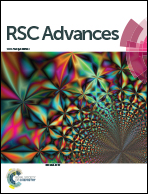Short-chain amino acids functionalized cellulose nanofibers composite ultrafiltration membrane with enhanced properties
Abstract
TEMPO-oxidized cellulose nanofibers (TOCNs) were blended with cellulose acetate (CA) to fabricate a high water flux ultrafiltration membrane. In order to further reduce the fouling behavior of the membrane, short-chain amino acids were selected as modifiers to graft onto the membrane surface. Some properties of modified membranes had been changed such as penetrability, contact angle, zeta potential, anti-fouling and mechanical properties. It was observed that the water flux of the TOCNs composite membrane was raised from 11.8 l m−2 h−1 to 123.4 l m−2 h−1, an over 10 times increment compared with unmodified CA membrane. As reinforcing nanofibers, TOCNs also have a positive impact for the modified membrane on mechanical properties. The tensile strength and elongation at break of the composite membrane were increased by 23.9% and 40.4%, respectively. After short-chain amino acids modification, little or even no variation had been found in the cross-section morphology and pore structure of the membrane. The flux recovery ratio (FRR) of lysine modified membrane was increased from 80.0% to 95.9%, while irreversible fouling loss (Rir) decreased from 20% to 4.1%. Grafting lysine onto the membrane effectively improved the resistance to protein fouling of the membrane, without sacrificing water flux and mechanical properties.


 Please wait while we load your content...
Please wait while we load your content...